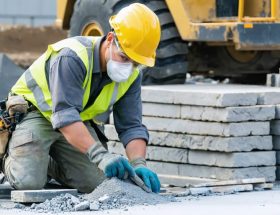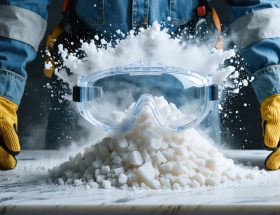Construction safety standards represent the critical foundation of every successful restoration project, directly impacting worker well-being and project outcomes. Recent industry data reveals that proper safety protocol implementation reduces workplace incidents by up to 85% while simultaneously improving project efficiency and quality control measures.
Stringent safety standards protect not only workers but also preserve valuable historic materials and architectural elements during restoration work. From proper scaffolding assembly to specialized personal protective equipment (PPE), each safety measure serves multiple purposes in protecting both human assets and irreplaceable stone features.
Modern construction safety encompasses a comprehensive framework of protocols, including:
– Real-time air quality monitoring systems
– Advanced fall protection equipment
– Specialized training for heritage material handling
– Digital safety compliance tracking
– Integrated emergency response procedures
For stone restoration professionals, these standards create a secure working environment while ensuring the preservation of historic materials through controlled, methodical processes. Understanding and implementing these safety measures is non-negotiable, forming the backbone of professional stone restoration practice and directly influencing project success rates, insurance costs, and industry reputation.
Professional stone restoration demands an unwavering commitment to safety standards that protect both workers and historic materials, establishing the foundation for successful project completion and long-term preservation.
Personal Protective Equipment Requirements

Respiratory Protection
Proper respiratory protection is essential in construction environments where airborne particles and silica dust are common hazards. Workers must use appropriate dust masks or respirators based on the specific task and level of exposure. For basic dust protection, N95-rated masks offer adequate filtration for non-hazardous particles. However, when working with silica-containing materials or in poorly ventilated areas, workers need NIOSH-approved respirators with proper cartridges.
Employers must implement a comprehensive respiratory protection program that includes fit testing, proper maintenance procedures, and regular inspections of equipment. Adequate ventilation systems, including local exhaust ventilation and dust collection systems, should be installed to minimize airborne contaminants at the source.
Workers should be trained on proper mask fitting, seal checks, and cleaning procedures. It’s crucial to replace filters and cartridges according to manufacturer recommendations and maintain detailed records of respirator maintenance. When natural ventilation is insufficient, mechanical ventilation systems must be employed to ensure proper air exchange rates and maintain safe working conditions.
Remember that respiratory protection is the last line of defense – prioritize engineering controls and work practices that reduce dust generation at the source.
Physical Protection Gear
Personal protective equipment (PPE) forms the first line of defense against workplace hazards in construction environments. Safety goggles are mandatory when working with stone materials, especially during cutting, grinding, or polishing operations to protect against dust, debris, and chemical splashes. These must meet ANSI Z87.1 standards and provide both front and side protection.
Work gloves are essential and should be selected based on specific tasks. Cut-resistant gloves are required for handling rough stone edges, while chemical-resistant variants are necessary when working with sealants or cleaning solutions. Gloves should fit properly and allow adequate dexterity while maintaining protection.
Steel-toed boots meeting ASTM F2413-18 standards are required on all construction sites. These boots must provide protection against falling objects, compression hazards, and feature slip-resistant soles. For enhanced safety, boots should also be water-resistant and provide adequate ankle support.
Protective clothing includes long-sleeved shirts and full-length pants made from durable materials. High-visibility vests are mandatory in areas with vehicle traffic or moving equipment. When working with wet applications or chemicals, water-resistant aprons or coveralls are necessary.
Hard hats must be worn at all times on construction sites and should comply with ANSI/ISEA Z89.1 standards. Regular inspection and replacement of all PPE items is crucial, with immediate replacement of any damaged or worn equipment.
Safe Equipment Operation Standards
Power Tool Safety
Power tools are essential in stone construction and restoration, but they require careful attention to safety protocols. Following safe equipment operation protocols is crucial to prevent accidents and ensure worker protection.
Always inspect tools before use, checking for damaged cords, loose components, or worn parts. Ensure all guards and safety features are properly installed and functioning. When operating grinders, maintain a firm grip with both hands and keep the tool’s body away from your core.
For polishers and sanders, start the tool before contact with the stone surface and lift off before powering down. Never disable or modify safety guards, regardless of the job’s complexity. Keep work areas well-lit and free from obstacles that could interfere with tool operation.
Proper personal protective equipment (PPE) is mandatory when using power tools. This includes safety glasses with side shields, hearing protection, and dust masks or respirators. Avoid loose clothing that could become entangled in moving parts.
Regular maintenance and inspection of power tools help prevent malfunctions that could lead to injuries. Replace worn parts immediately and keep tools clean and properly lubricated. Store tools in dry, secure locations when not in use, and never carry tools by their power cords.
Remember that fatigue can impair judgment and control. Take regular breaks and never rush through power tool operations, as precision and safety are paramount in stone construction work.

Equipment Maintenance Protocols
Regular equipment maintenance is crucial for ensuring workplace safety and optimal performance in construction settings. All machinery and tools must undergo systematic inspection before each use, with comprehensive maintenance checks scheduled at predetermined intervals based on manufacturer recommendations and usage patterns.
Daily inspections should focus on checking fluid levels, examining moving parts for wear, and ensuring all safety features are functioning properly. Operators must maintain detailed maintenance logs documenting inspection dates, findings, and any repairs performed. These records serve as essential documentation for compliance purposes and help track equipment reliability over time.
Key maintenance protocols include:
– Testing all safety switches and emergency stop mechanisms
– Inspecting electrical cords and connections for damage
– Checking hydraulic systems for leaks or pressure issues
– Verifying proper calibration of measuring instruments
– Examining cutting tools for sharpness and structural integrity
– Ensuring all guards and protective devices are properly installed
When defects are identified, equipment must be immediately tagged out of service and repaired by qualified personnel. Only after thorough testing and verification should equipment be returned to operation. Implementing a preventive maintenance schedule helps reduce unexpected breakdowns, extends equipment lifespan, and most importantly, prevents accidents caused by equipment failure.
Training programs should ensure all operators understand proper maintenance procedures and can identify potential issues before they become safety hazards.
Chemical Safety Protocols
Storage and Handling
Proper storage and handling of chemicals in stone construction and restoration requires strict adherence to established chemical safety guidelines. All chemicals must be stored in their original containers with clear, legible labels in a well-ventilated, temperature-controlled area away from direct sunlight. Maintain separate storage areas for incompatible materials to prevent dangerous reactions.
When mixing chemicals, always work in a properly ventilated space while wearing appropriate personal protective equipment (PPE), including chemical-resistant gloves, safety goggles, and respiratory protection when necessary. Use precise measurements and follow manufacturer instructions carefully to ensure proper dilution ratios.
For disposal, collect waste materials in appropriate containers and label them clearly. Never pour chemicals down drains or dispose of them in regular trash. Contact local waste management authorities for proper disposal procedures of hazardous materials. Maintain detailed records of all chemical purchases, usage, and disposal to ensure compliance with regulations and enable effective inventory management.
Keep spill containment kits readily available and ensure all workers are trained in their use. Regular safety audits of storage areas help maintain compliance and identify potential hazards before they become problems.

Emergency Response Procedures
In the event of chemical exposure or spills during construction work, quick and appropriate response is crucial. Immediately evacuate all personnel from the affected area and ensure proper ventilation. If skin contact occurs, remove contaminated clothing and flush the affected area with clean water for at least 15 minutes. For eye exposure, use an emergency eyewash station and seek medical attention immediately.
Contain the spill using appropriate absorbent materials from your spill kit, such as vermiculite or chemical-specific absorbent pads. Never use water to clean up chemical spills unless specifically instructed by the Safety Data Sheet (SDS). Properly dispose of contaminated materials in designated hazardous waste containers.
Contact your site supervisor and emergency response team immediately. Document the incident, including the type of chemical, amount spilled, and actions taken. Keep the SDS readily available for emergency responders and medical personnel. After the situation is contained, conduct a thorough investigation to prevent future incidents and update safety protocols as needed.
Ensure all workers receive regular training on spill response procedures and maintain well-stocked spill kits at designated locations throughout the construction site.
Worksite Safety Requirements
Site Preparation
Proper site preparation is fundamental to ensuring a safe construction environment. Begin by establishing a clear perimeter around the work area using highly visible barriers such as safety fencing, caution tape, or physical barricades. These barriers should effectively separate construction activities from public areas and clearly define restricted zones.
Install comprehensive signage that includes warning notices, emergency contact information, and required personal protective equipment (PPE) indicators. Place these signs at all entry points and strategic locations throughout the site. Ensure signs are visible, weather-resistant, and comply with local regulations.
Designate specific containment areas for different purposes:
– Material storage zones for tools and equipment
– Waste collection and disposal areas
– Chemical storage facilities with proper ventilation
– Emergency assembly points
– First aid stations
– PPE distribution and storage areas
Create dedicated pathways for worker movement and equipment transportation, marking them clearly with appropriate directional signs. Establish dust control measures, including proper barriers and ventilation systems, particularly when working with natural stone cutting or grinding.
Install adequate lighting throughout the site, especially in high-traffic areas and emergency exits. Maintain daily inspection logs of all site preparation elements to ensure continued compliance with safety standards.
Environmental Controls
Proper environmental controls are crucial for maintaining a safe construction environment, particularly when working with natural stone. Dust management requires implementing a comprehensive system of dust collection devices and regular cleaning protocols. HEPA-filtered vacuum systems should be used for capturing fine particles, while wet cutting techniques can significantly reduce airborne dust during stone fabrication.
Adequate ventilation is essential, especially in enclosed spaces where stone cutting or grinding occurs. Mechanical ventilation systems should maintain a minimum of 6 air changes per hour, with proper filtration to remove particulates. For areas with limited natural airflow, portable ventilation units can provide additional air movement and improve working conditions.
Temperature and humidity control also play vital roles in workplace safety. Excessive heat can lead to worker fatigue and dehydration, while high humidity may create slippery conditions on stone surfaces. Climate control systems should maintain temperatures between 68-76°F (20-24°C) when possible, with relative humidity levels between 30-50%.
Regular monitoring of workspace conditions using air quality meters and particulate counters helps ensure environmental controls remain effective. Documentation of these measurements should be maintained, and adjustments made to control systems as needed to maintain optimal working conditions.
Training and Certification Standards
Workers in stone restoration must undergo comprehensive safety training and obtain necessary certifications before working on construction sites. The OSHA safety requirements mandate specific training programs that cover essential safety protocols and equipment operation.
All workers must complete a 10-hour OSHA construction safety course, which covers fall protection, proper lifting techniques, and hazard recognition. Supervisors are required to complete the more extensive 30-hour program, which includes additional modules on safety management and emergency response procedures.
Equipment-specific certifications are mandatory for operating machinery like forklifts, cranes, and aerial work platforms. These certifications must be renewed every three years and require both classroom instruction and practical demonstrations of competency.
Personal Protective Equipment (PPE) training is essential and must be documented. Workers need to demonstrate proper understanding of respiratory protection, especially when working with silica dust, and show proficiency in selecting and maintaining appropriate protective gear.
First aid and CPR certification is required for at least one person on each work crew, though it’s recommended for all workers. These certifications must be renewed every two years to ensure knowledge stays current.
Workers handling hazardous materials must complete Hazard Communication (HAZCOM) training and maintain current certification. This includes understanding Safety Data Sheets (SDS) and proper chemical handling procedures.
Regular safety refresher courses are mandatory, typically conducted quarterly, to reinforce best practices and update workers on new safety protocols or equipment. Companies must maintain detailed training records for each employee, including certification dates, expiration dates, and specific areas of competency.
For specialized restoration work, additional certifications may be required based on the specific materials and techniques being used. These might include historic preservation certifications or specific manufacturer training for proprietary restoration products and equipment.
Construction safety standards are not just regulatory requirements but essential safeguards that protect lives and ensure project success. Following proper safety protocols, from wearing appropriate PPE to maintaining clean workspaces and using tools correctly, creates a foundation for efficient and secure stone restoration work. Regular training, clear communication, and strict adherence to safety guidelines help prevent accidents and create a culture of safety awareness. Remember that safety measures evolve with industry advancements, making it crucial to stay informed about current standards and best practices. By prioritizing safety in every aspect of stone restoration work, professionals protect themselves, their teams, and their clients while maintaining the highest quality craftsmanship in the industry.










